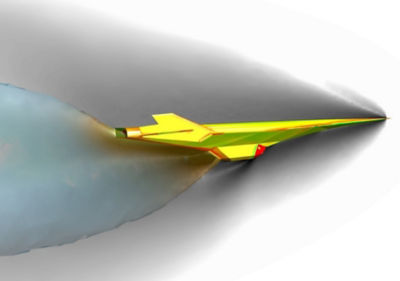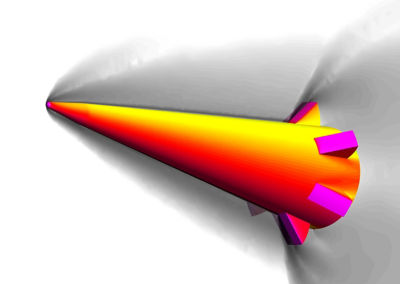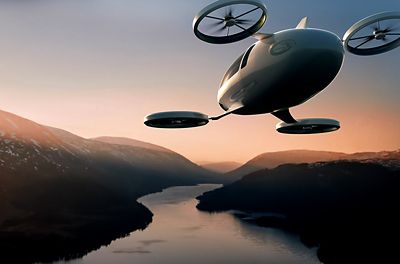ANSYS BLOG
July 20, 2022
Hyperfocused on Hypersonics: Using Simulation to Enhance Defense Capabilities
If you’ve read, watched, or listened to any news outlet in the last few months, you’ve probably heard about hypersonic missiles. For many of us, though, this may be the first time we’re hearing about this method of defense, or about hypersonic speeds in general.
However, aerospace and defense (A&D) engineers are well-versed in hypersonics.
First, let’s explain what hypersonic actually means. Essentially, hypersonic means hyper-fast. Hypersonic speeds are so fast that they make a speeding bullet look slow. While the average bullet travels a little over Mach 1, a hypersonic vehicle can fly faster than five times the speed of sound (i.e. Mach 5, or 3,836 mph), up to Mach 30 or even beyond. As such, hypersonic speeds can only be achieved by certain spacecraft, aircraft, rockets, and missiles.

Still, despite the A&D industry’s familiarity with hypersonics, employing hypersonic vehicles as effective mechanisms of national defense remains a developing area of research. To fully understand this area and better equip the defense sector with the latest advancements, more members of the A&D industry are turning to simulation to address the combined effects of complex areas of physics, including aerothermodynamics, advanced structures and materials, additive manufacturing, control systems and avionics, and electromagnetics (EM).
Creating a Connected Digital Thread to Ensure Mission Success
Gaining a competitive advantage in the defense domain depends on modernizing capabilities, which is only possible through digital transformation. To stay ahead of adversaries — in novel strategic deterrence methods and other areas — capabilities must be delivered faster. Simulation accelerates technology production and can increase confidence in mission success by predicting real-world performance.
While hypersonic applications offer clear advantages in terms of operational effectiveness (e.g., speed and range), they also present a unique set of challenges related to the vehicle’s design, thermal protection system (TPS), survivability, propulsion, controls, sensors, and communication. But the next generation of hypersonic vehicles are pushing the limits of what is possible in each of these areas, including the ability to detect and track in all domains.
To develop competitive hypersonic defense strategies, we must first modernize our hypersonic defense capabilities. One way to do this is by embracing digital mission engineering platforms likeAnsys STK, which combines digital modeling, simulation, testing, and analysis to evaluate mission outcomes at every phase of a system’s life cycle.
Additionally, by integrating automation software likeAnsys ModelCenter, which connects mission and system requirements to engineering analysis, engineers can create, connect, and automate multi-tool workflows, optimize product designs, and leverage model-based systems engineering (MBSE) for vehicle design, technology, and concept of operations (CONOPS).
Similarly, engineers can secure critical simulation data, provide process and decision support, and connect powerful simulation and optimization solutions to existing tools and processes withAnsys Minerva.
Combined, these technologies provide a powerful solution for traceability by establishing a connected digital thread — a key requirement for developing an accurate digital twin. A digital twin is a virtual representation of real-world entities and processes, synchronized at a specified frequency and fidelity, according to theDigital Twin Consortium.
Companies are increasingly turning toAnsys Twin Builderto build, validate, and deploy simulation-based digital twin models with hybrid analytics. This capability enables engineers to reach an unparalleled level of accuracy by combining machine learning (ML)-based analytics with a physics-based approach to perform real-time systems analyses to predict operational performance, implement design optimizations, and schedule predictive maintenance.

Schlieren image highlighting the shock formations for a generic atmospheric re-entry body. Colors show surface pressure.
Vehicle Design and Thermal Protection Systems
Due to the high speeds involved in hypersonic flight, vehicles experience extremely high temperatures and pressures. Computational fluid dynamics (CFD) simulation, such asAnsys Fluent, can help engineers better understand complex effects like shock waves, turbulence, plasma formation, and heat loading. Understanding this behavior is incredibly important for counter-hypersonic applications, such as the resulting effect of a laser beam hitting the surface of a hypersonic vehicle.
Engineers can also use CFD coupled with digital mission engineering solutions likeAnsys STK Aviatorto develop trajectories best suited for the vehicle’s airframe and control surface while increasing maneuverability even at the fastest speeds.
To improve the strength and decrease the weight of the airframe of hypersonic vehicles, engineers can integrate finite element analysis (FEA) simulation withAnsys Mechanicalto perform structural and thermal analyses. By observing the effects of temperature and pressure, designers can improve overall survivability and enhance other aircraft components, such as heat shield design.
Efficient materials selection made possible withAnsys Granta Selector, not only accelerates development, but also allows for engineers to select the most appropriate materials from thousands of options to optimize thermal and structural performance. For example, optimized materials selection can advance heat shield design further by choosing the best material to prevent hot air from entering the hypersonic vehicle and mitigate damage caused by debris.
With virtual validation, all components become easier to design, test, and validate, including the vehicle’s TPS.
One company that is applying simulation in this manner is A&D development and manufacturing firm Textron Systems. Textron Systems and Ansys are working together to combine Textron Systems’ longstanding experience in TPS materials technology with Ansys’ simulation-powered thermal and aerodynamic analyses. A TPS protects a vehicle from aerodynamic heating. Some factors to consider when choosing materials for hypersonic vehicles include the material’s oxidation and thermal resistance, temperature capability, durability, and weight.
By pairing Textron Systems’ experience with flight-tested, high-temperature composite materials and Ansys’ simulation tools, their business is able to enhance, advance, and validate its state-of-the-art systems even better than before.
“Years ago, Textron Systems pioneered the advanced materials used for TPS on Apollo and other applications, developing in-house simulation tools calibrated to flight test data for specific geometries,” says Michael Kraft, senior vice president of Applied Technologies and Advanced Programs at Textron Systems. “Our efforts with Ansys will enable us to expand these tools to other types of vehicles and integrate our work with the wide suite of Ansys multiphysics simulation tools used by academia and industry today.”
Simulation enables Textron Systems to perform complex aerodynamic analyses of hypersonic applications, including varied vehicle behaviors that occur under different design conditions, materials, and temperatures.
“Modern engineering simulation technologies are enabling the development of high-performance hypersonic systems, such as TPS, that are lighter, more robust, and better at handling the extreme high temperatures encountered during atmospheric reentry than TPS from just one generation ago,” says Valerio Viti, principal engineer and the solution architect for hypersonics at Ansys.
Likewise, simulation is critical in other areas of hypersonic defense research to accelerate innovation, design, and development while increasing confidence in mission success by predicting real-world performance with high accuracy.
“Over the past few years, the resurgence in interest in hypersonic technology highlights the need to leverage computer simulations to design these complex systems,” adds Viti. “Given the extreme costs of flight testing, the limited availability, and limitations of ground-based test facilities, computer simulation is a critical technology to stay ahead in the development of hypersonic systems.”
Developing Innovative Propulsion
为了开发创新和强劲的支撑ulsion systems capable of propelling vehicles into sustained hypersonic flight, novel approaches are being explored for more advanced and efficient airbreathing engines. One example is a rotating detonation engine (RDE), which creates spinning detonation waves to compress and combust the fuel to generate thrust instead of burning propellant in a traditional burn-through linear combustor chamber.
联合循环、混合推进也是拜因g used for hypersonic flight. For those who watched the blockbuster success “Top Gun: Maverick,” you may have noticed that the fictional DarkStar SR-72 hypersonic plane used a dual-mode ramjet propulsion system. From takeoff to Mach 3, thrust was provided by a turbine engine. To reach high hypersonic speeds, Maverick, played by Tom Cruise, switched over to a dual-mode ramjet system that shared a common inlet and nozzle with the turbine engine.
In conjunction with multiphysics simulation solutions mentioned above, high-fidelity simulations of thermal loads, structural deformation, and more can also be performed in model-based development environments for reliable embedded software such asAnsys SCADEto understand and optimize the behavior and performance of airbreathing engines, solid propellants, and hybrid systems.
Controls, Communications, and Sensors
Developing resilient controls, sensors, and communication sensors for hypersonic vehicles presents a variety of challenges due to the severe temperatures, shock, and vibration experienced during flight. Ansys helps engineers take a multidisciplinary approach to tackle the system integration of controls, sensor fusion and actuation, guidance, and control.
Safe and secure avionics and flight control systems are critical to the reliable operation of hypersonic vehicles.Ansys medini analyzeand Ansys SCADE provide key model-based safety analysis methods, embedded software development, and simulation environments to efficiently ensure functional safety, mitigate cybersecurity threats, and develop certified embedded software.
At hypersonic speeds, a plasma sheath with a high attenuation factor — propensity to reduce in strength — forms around the air vehicle causing a communication blackout. By coupling two industry-leading simulation technologies such as Ansys CFD solutions and Ansys’ EM tools likeAnsys HFSS, engineers can prevent communication degradation and blackout by predicting flow ionization interference with other communication systems. Furthermore, by simulating the plasma distribution around the vehicle in STK, the radar cross-section of a hypersonic vehicle can be accurately computed.
Another challenge in hypersonic defense is how to validate the detection and tracking of incoming hypersonic vehicles. In similar A&D exploration, infrared sensors are typically mounted on platforms, such as satellites or unmanned aerial vehicles (UAVs). However, the physical testing of hypersonics is extremely expensive, potentially hazardous, and can only cover a very limited range.
With the above difficulties with testing in mind, simulation offers a viable way to virtually recreate hypersonic scenarios safely, at significantly lower costs, and with accuracy. Ansys CFD tools can be used to compute the temperature of the incoming vehicle’s surface, propulsion system, and plume. This thermal information can then be processed using Ansys’ optical tools to create a realistic thermal image that reflects surface emissivity and atmospheric effects. These high-fidelity thermal images can then be integrated into theAnsys Systems Tool Kit (STK) electro-optical infrared (EOIR) module, which can illustrate large-scale simulations in an applied setting. With this capability, engineers can analyze countless scenarios and variables, including how an infrared sensor mounted on a satellite in a given Earth orbit would detect and track an incoming hypersonic vehicle.
Beyond detection and tracking, one of the toughest design challenges of next-generation hypersonic vehicles are sensors that are robust enough to withstand temperatures in excess of 1100° C (1,832° F), vibration experienced during flight, and distortions created by turbulence. Evaluating optical sensor performance to account for wavefront aberrations caused by turbulent flow fields and thermal deformations of the sensor window can be achieved with Fluent, Mechanical andAnsys optical tools.
Forging Forward in a Flash
可能requ高超音速的物理测试系统ired for certain use cases but high-fidelity simulations, multiphysics tools, and digital mission engineering solutions can minimize the need to fly physical tests. When physical tests must be performed, the speeds involved and nature of the systems being tested means traditional methods need to be adjusted and accelerated. The test evolution must be tightly scripted to execute perfectly the first time. A tool like STK is perfectly suited to determine where the participants need to be, when they need to be there, and where they need to be looking in order to collect the required data.
As demands for hypersonic technology increase, theU.S. Department of Defenseis funding 18 research projects through the University Consortium for Applied Hypersonics (UCAH). The projects, led by UCAH university partners, will compile critical research on the development of hypersonic applications as effective defense mechanisms. In one project, researchers at theUniversity of Texas at Arlingtonand theMissouri University of Science and Technologywill leverage Ansys’ CFD simulation software to analyze, test, and validate complex phenomena surrounding hypersonic missile travel. The scope of the research will include the physical testing and computer simulation of the effect of lasers on vehicle models at hypersonic speeds.
TheUniversity of Texas at Arlington (UTA)and Ansys are also developing anadvanced design and analysis workflowfor validating system models in the U.S. government's current and next-generation hypersonic vehicles. The workflow will fast-track certification of simulation software codes, help decrease hypersonic technology development spending and increase engineering productivity.
To learn more about Ansys’ A&D solutions and participation in the Farnborough International Airshow, visitAnsys' event page. If you’re attending, set up ameetingwith us in advance or stop by Ansys’ indoor booth (#4960) or outdoor chalet (#C224) during the show.













